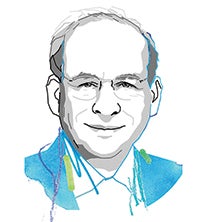David W. Leebron
An Evolving Community

The term “university” is generally derived from the fuller Latin designation of “universitas magistrorum et scholarium,” meaning a “community of teachers and scholars.” Indeed, that notion of community as intimately connected to higher education and scholarship has a long pedigree around the world.
There are a number of claims to being the first university, or more broadly an institution of higher learning, including the Platonic Academy founded by Plato in Athens in 387 B.C.; Nalanda University in northern India established around the fifth century; the University of Karueein founded in the ninth century as a mosque in Fez, Morocco; and the University of Bologna founded in 1088 and regarded as the oldest university in continuous existence. In each case, the university was constituted both as a community of scholars and as a place, which ultimately evolved into the university campus.
In his founding address, “The Meaning of the New Institution,” President Edgar Odell Lovett spoke eloquently of the centrality of community. He referred to “a company of students and fellows, lecturers and instructors, preceptors and professors, who in a common society would seek to realize a composite conception of student-universities and the master-universities of earlier times.” He spoke further of “a society of scholars which from the first aspires to be a ‘partnership in all science, a partnership in all art, a partnership in every virtue and in all perfection,’” quoting Edmund Burke. He concluded that section of his remarks by quoting from William Wordsworth’s epic poem “The Prelude”:
Nor was it least
Of many benefits, in later years
Derived from academic institutes
And rules, that they held something up to view
Of a Republic, where all stood thus far
Upon equal ground; that we were brothers all
In honour, as in one community,
Scholars and gentlemen
In this history, this sense of community has been strongly tied to place — so strongly, for example, that 800 years after its demise, Nalanda University was revived in a city near its original site. Lovett connected not only the shared sense of place to the university community, but also emphasized the importance of the beauty of the campus and its architecture. Today, we still consider the landscape and buildings of our campus integral to creating our community.
That notion of community is now being challenged, and not necessarily in bad ways. During the pandemic, much of our community was distant from its common physical place. Our educational mission became separated from its direct connection to our campus, although, unlike many other universities, we kept our campus in operation throughout the 2020–2021 academic year for all students who wished to be here. We sought simultaneously to create new senses of community among the virtual or online participants.
Suffused through Lovett’s remarks was also an emphasis on equality and what today we would call “inclusion” as aspects of our community. This is reflected in the previous quote from Wordsworth: “where all stood thus far upon equal ground; that we were brothers all.” The quote from Wordsworth continues:
Distinction open lay to all that came,
And wealth and titles were in less esteem
Than talents, worth, and prosperous industry.
Lovett failed to note that the “New Institution” explicitly excluded under its charter about 18% of the Texas population, namely nonwhites.
... [A]s the pandemic wanes in its impact in the United States and we anticipate a relatively normal fall, we are asking how our experience has changed our experience of community, and in particular the role of our physical and campus presence.
I write this column as we seek to address two circumstances. First, as the pandemic wanes in its impact in the United States and we anticipate a relatively normal fall, we are asking how our experience has changed our experience of community, and in particular the role of our physical and campus presence. Although we anticipate ultimately making significant changes, we do not lightly want to embark on a path that may diminish our community before we refamiliarize and remind ourselves of its benefits. At the same time, however, we cannot shrink from the challenges and opportunities posed by new possibilities, whether ways of working or ways of learning, that may lead to new kinds of educational community that extend our reach.
Second, the Task Force on Slavery, Segregation and Racial Injustice has just issued its first report, focusing in particular on the entanglement of William Marsh Rice with slavery. Ultimately, the work of the task force is also designed to challenge us — to challenge us to achieve more effectively the equality and inclusion that was envisioned yet deeply flawed from the outset.
Community, as much as it is the foundation of a university, cannot be static. It cannot be static either in who makes up that community or in the methods by which it is constituted. We ought not fight these challenges to our comfortable sense of community, but rise to them. Rice set high aspirations at its founding, and we often quote Lovett’s words about establishing “no upper limit” on the new university’s aspirations and endeavors. The same thinking must apply to our core idea of community: How can we best extend it while still embracing even more strongly the fundamental idea of a community of teachers and scholars?
— David W. Leebron
